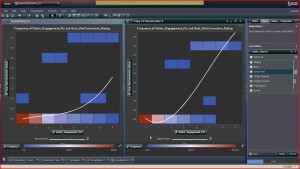Developments in advanced analytics, data visualization and processing power are opening new doors to solve big data marketing problems. Most notably, the time horizon on our perspective has broadened into the future by progressing
- From descriptive analysis (What happened?)
- To diagnostic analysis (Why did it happen?),
- To predictive analysis (What will happen?) and then
- To prescriptive analysis (How can we make it happen?).
These issues and opportunities span the enterprise in terms of impact, but the locus is in marketing because much of big data is customer data. And how visualization applies to marketing is where it gets interesting.
Marketers of all stripes share two common goals:
- Getting a holistic view of customers, and
- Predicting how customers will respond to your marketing efforts.
Those goals in the complexity of today's digital marketing environment translate to all sorts of questions, including:
- Why do customers interact with your brand?
- How do customers engage with your digital properties (single or multidomain) across multiple experiences and touch points?
- What type of content do customers and prospects spend the most time engaging with and, more importantly, why?
- Which channels work together to attract and create higher-value traffic segments from an integrated marketing perspective?
- What types of interactions have predictive value in leading to conversions?
- What will happen to digital traffic if more advertising dollars are spent on paid search versus display – and vice versa?
Finding the answers to these questions has been difficult. Many digital-savvy marketers have long been frustrated in their attempts to achieve a comprehensive, forward-looking understanding of customers. Part of the challenge has been the siloed nature and varying structures of digital data sources. Another part has been the limitations of Web analytics tools that aggregate and report on what happened in the past, but lack the sophistication of predictive marketing analytics.
The bottom line is that obtaining a holistic view of customers is a classic big data problem because it requires you to capture, prepare, manage, integrate and analyze huge amounts of digital data. The good news? It’s getting easier to do those things, thanks to developments in advanced analytics, data visualization and big data processing power.
Want to learn more? We captured the highlights in a paper of a webinar produced by the Direct Marketing Association (DMA) for SAS featuring solutions architect Suneel Grover. It explores how data visualization can enable marketers to become more predictive and prescriptive in their digital and integrated marketing efforts. This paper is titled, Empowering the Digital Marketer with Big Data Visualization - register to download it today!
Let us know what you think. And as always, thank you for following!

